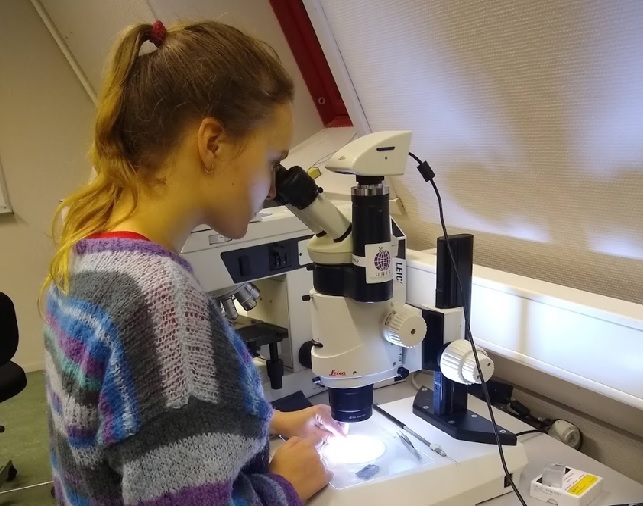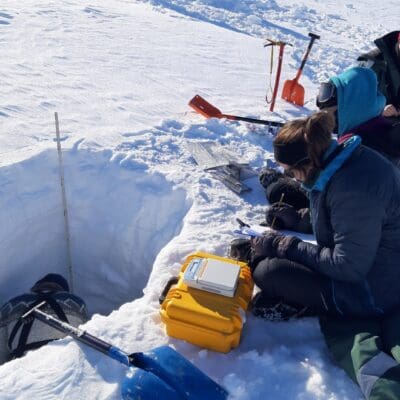Use certification to assess practical skills in lab and field
On this page we provide information on how to create certification protocols for a set of lab and field skills commonly used in terrestrial ecology.
active

When working with terrestrial samples in the lab it is important to know how to operate a microscope. Photo: Anne Colgan
About the project

In many course learning outcomes, we state that certain practical skills in basic lab and field methodology will be learned, such as the skills of vegetation recording. But are we actually assessing those skills? Or do we just assume that they have been learned without ever explicitly testing this? In this project we aim to develop a certification process to assess lab and field skills related to operate a microscope, performing snow profiles, vegetation analyses as well as a set of measurements on abiotic parameters in the field.
Methods
The certification process is done in several steps either in a lab or in the field. As a first step, a general introduction and a demonstration of the activity is given. Instructional videos can also be added as preparation material. After that, students get together in pairs and discuss what they just learned. For each certification step, a document (tick-off list) is available providing students with information on what they need to show when being certified. Once confident, they ask the teachers or already certified fellow students to be certified. During the certification, the students need to explain and show how to use the equipment mentioned on the tick-off list. It can also entail several steps depending on the complexity of the activity. If students fail during the certification, they can practice once more, and then again ask to be certified. Once they have been successfully certified, they get a tag (we used post-it notes) and can then certify others. They are not allowed to certify their neighbor they initially discussed the material with. Once the students have passed the activity, they will get a physical certificate stating which skills they have mastered.
The certification process could also be leveled, with different qualification skill levels where students can choose which level they would like to be certified in and this will be stated on their certificate. Statement of a higher skill level could motivate students and enhance their learning and skill training.Generally students would like more time to practice between introduction and being certified.
The certification protocol was first developed for microscopy skills in lab courses. To evaluate the usefulness of certification, a questionnaire was sent out to all students. An important feedback from students was that they would like more time to practice between introduction and being certified. Based on the our experience and student feedback the certification protocol was further developed and tested on a set of field skills such as the ability to perform snow profiles, vegetation analyses as well as a set of measurements on abiotic parameters.
The project is still in development; right now, rather than being summative assessment, it is a learning activity with integrated assessment for learning. Challenges include what to do when students fail certification several times but still need to operate the equipment and how to integrate certification as an assessment tool at the organizational level.
Outcomes and related publications
A certification protocol and a certificate were created and tested on students. To evaluate the usefulness of the certification procedure, a questionnaire was sent out to all students. At UiO and UiB instructional videos on microscopy were created and integrated in the protocol. Our next step at UNIS is to develop instructional videos on vegetation analysis and snow pit measurements to improve preparation before going to the field.
Certification of practical lab and field skills is currently being shared in order to encourage others to test this approach. The certification of field skills will be presented at the MNT conference in 2023.
You will find examples of an assignment certificate, example of a tick off-list, a questionnaire, course instructional microscope videos and an example of a microscope certificate below. When ready, examples of field instructional videos will also be available on this page.
- Assignment and tick-off list for certification TEMPLATE
- Example assignment and tick-off list for certification of microscope skills
- Example questionnaire for certification of snow measurements
- Course instructional microscope video UiB
- Course instructional microscope videos UiO
- Microscope DM750 certificate
Eidesen, P.B., A. Bjune & S. Lang (2022) Learning through assessment exchange the lab report with certification of microscopy skills. Poster, UNIS Learning Forum 2022.
Lang, S., P.B. Eidesen & A. Bjune (2022) How to assess practical skills in lab and field settings. Workshop. UNIS Learning Forum 2022
Connected staff
External partners:
Pernille Bronken Eidesen (UiO)
Anne Bjune (UiB)
